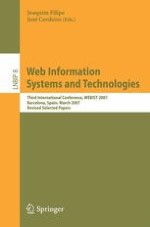This book contains the best papers from the International Conference on Web Inf- mation Systems and Technologies (WEBIST 2007), organized by the Institute for Systems and Technologies of Information, Control and Communication (INSTICC), endorsed by IW3C2, and held in Barcelona, Spain. The purpose of WEBIST is to bring together researchers, engineers, and practit- ners interested in the technological advances and business applications of web-based information systems. It has four main topic areas, covering different aspects of web information systems, namely, internet technology; web interfaces and applications; society, e-business and e-government; and e-learning. WEBIST 2007 received 367 submissions from more than 50 countries across all continents. After a double-blind review process, with the help of more than 200 - perts from the international program committee, and also after presentation at the conference, 23 papers were finally selected. Their extended and revised versions are published in this book. This strict selection made the conference appealing to a global audience of engineers, scientists, business practitioners, and policy experts. The - pers accepted and presented at the conference demonstrated a number of new and innovative solutions for e-business and web information systems in general, showing that the technical problems in this field are challenging and worth further R&D effort. The program of this conference also included three outstanding keynote lectures presented by internationally renowned distinguished researchers. Their keynote speeches reinforced the overall quality of the event.
